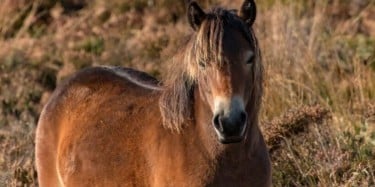
EXMOOR PONY
33SHARES369VIEWSShare on TwitterShare on Facebook A little horse or pony

A little horse or pony breed from Britain is called the Exmoor Pony. It belongs to the greater Celtic group of European ponies since it is one of the breeds of mountain and moorland ponies endemic to the British Isles: 465 it comes from, and is named for, the moorland region of Exmoor in northeastern Devon and western Somerset in southwest England. It is well suited to the moor’s harsh environment and inadequate feeding. While most of them are privately owned, others still reside there in a nearly feral state.
The Domesday Book, published in 1086, is the first written account of ponies in Exmoor. The majority of Exmoor was sold in 1818 after being used for centuries as a hunting ground rather than a “Royal Forest.” Thirty ponies, identified as the original old type, were moved to neighbouring moorland; these were the foundation stock of the present-day breed. A breed society, the Exmoor Pony Society, was formed in 1921; the first stud-book was published in 1963.
Due to poaching for food during World War II, the ponies almost went extinct. A tiny group of breeders labored to conserve the stock that remained after the war, and in the 1950s, some of it was sold to Canada and continental Europe. After the breeding population’s vulnerability was made known in 1981, numbers started to rise again. With 95 head recorded in the UK for 2021 and an estimated 330 head worldwide, this breed is critically endangered in the twenty-first century. The Rare Breeds Survival Trust has designated its conservation status as “priority,” indicating the highest level of concern on the trust’s part.
History
Ponies were first mentioned in the Exmoor region in the Domesday Book in 1086, but there is no mention of the ponies that roamed the Exmoor Royal Forest because they belonged to the King and were exempt from taxes. The Royal Forest was tended to over the ages by a succession of Wardens who levied fees for the grazing of animals, especially ponies. When a Warden’s term came to an end, as it did in 1748 for the Hill and Darch wardenship, they would frequently sell the ponies they personally owned. It is not documented if any of them were sold to newly hired Wardens. Sir Thomas Acland, the Warden, was grazing ponies on the Forest in 1767. The colours black, grey, bay, dun, ‘chestnut’, and sales data from 1805 and 1809 are listed and piebald for ponies, and illustrations from the 19th century depict the breed’s range of white markings. Research differs on the significance of this: some contend that it demonstrates that the native type of Exmoor pony was not restricted to bay, brown, and dun with mealy, and that other coat colors were purposefully bred out to create a specific look that fit a romanticized native breed narrative; others argue that cross-bred mares of different colors could coexist with the indigenous type because only the Warden could run stallions.
John Knight purchased the Royal Forest and a portion of the surrounding territory in 1818. Thirty of “the old type” were taken to Ashway Side near Winsford Hill by the departing warden, Sir Thomas Acland, while the remaining ones were sold to nearby farmers. Following that, records indicate that Acland implemented two breeding strategies: some independent crossing experiments on Winsford Hill and a closed, purebred herd on Ashway Side. John Knight, on the other hand, began breeding Arabians, Thoroughbreds, and other breeds with all the ponies he had bought in 1826 in an attempt to make them larger. It is noteworthy that the current registered population of Exmoor ponies is descended from the Acland herd.
Exmoors were deliberately bred for their distinctive mealy muzzle starting in the late 1800s. The grey and black ponies were welcomed under the guidelines of the newly established Exmoor Pony Society in 1921, along with bay, brown, and dun ponies. However, the color requirements were quickly tightened to eliminate any ponies that did not meet the precise breed standard. True dun and chestnut pangaré individuals are also known to exist in Herd 23, yet the chestnut individuals are not currently excluded from the registry. The Polo & Riding Pony Stud Books (the National Pony Society Stud Books from 1913) had registrations for Exmoor ponies as well as any ponies from the Exmoor region. In 1963, the Exmoor Pony Society released its first stud book, which was available only to registered Exmoor ponies.
Mary Etherington was one of the few breeders who sought to rebuild the herds after the war. First introduced to Canada and continental Europe in the 1950s, Exmoors are being kept in small numbers in these two regions today. Small, free-ranging herds of Exmoor ponies have been developed around the UK since the mid-1980s; their purpose is to oversee the vegetation on nature reserves owned by entities like the National Trust, Natural England, and County Wildlife Trusts. Exmoor ponies have become more and more in demand for “rewilding” initiatives in the UK and other European nations since the beginning of the twenty-first century.
A British charity called the Moorland Mousie Trust was founded in 2000 to help preserve the Exmoor pony. There is hardly any demand for Exmoor.
All purebred registered Exmoors were hot-branded for unique identification up until 2009. Then, with microchipping providing a workable substitute, breeders of in-ground cattle—not herds from moorland areas—ceased to brand. A few years later, hot branding for all but semi-feral ponies—for which there is no practical substitute—became prohibited in Britain.
Features
The color of the Exmoor pony coat is mostly “brown,” a dark bay variation; others are lighter and are referred to as “bay.” Dun exmoors are more infrequently found and are permitted by the registration. Pangaré (“mealy”) marks around the eyes, muzzle, and underbelly are present on all Exmoors. Other horses also have pangaré markings, which are regarded as a primordial characteristic. For Exmoor ponies to be listed in the stud book, they must not have white markings. In height, the majority of Exmoors range from 11.1 to 12.3 hands (45 to 51 inches, 114 to 130 cm) (45 to 51 inches, 114 to 130 cm), with the recommended height limit for mares being 12.2 hands (50 inches, 127 cm) (50 inches, 127 cms) and that for stallions and geldings 12.3 hands (51 inches, 130 cm). A few reach 13.2 hands
With a stocky, powerful build, the Exmoor pony is strong for its height, and noted for its hardiness and endurance. The chest is deep and the back broad, the croup level. The legs are short, with good bone and hard hooves. Although many sources state that the Exmoor has a distinctly different jaw structure from other horse breeds, which includes the beginnings of development of a seventh molar, this is a misunderstanding based on an incorrect translation of a German study. The study refers to an extra branch of blood supply to the jaw and speculates that this might have been the early stages of evolving an extra molar. However the feature is found in a number of horse breeds with sizable lower jaws, so its presence in the Exmoor pony is unremarkable.
The Exmoor, like most cold-weather adapted pony breeds, has a winter coat consisting of a highly insulating woolly underlayer and a topcoat of longer, oily hairs that prevent the undercoat from becoming wet by diverting water down the sides of the animal to fall from just a few drip areas. The mane and tail are thick and long, and the dock of the tail has a fan of shorter, coarser hairs, called a “snow chute,” that deflects rainwater away from the groin and underbelly areas.
Appreciations
Before agricultural mechanization arrived, hill farming was the main usage for tamed and trained Exmoor ponies that were taken from the moorland herds. Feed transportation, shepherding, and plowing/harrowing were the tasks completed. The people of Exmoor were able to travel by driving or riding them. Some were probably sold as pit ponies, and others were taken from the moor to work in harness somewhere.
Since these former uses have ended, excess in-ground (on farms, studs, etc.) moorland-bred foals and ponies are put to use for a range of recreational pursuits, including as agility, long-distance riding, driving, and displaying. 2003 saw Stowbrook At the Olympia Christmas Show, Jenny Wren became the first Exmoor to win the NPS Bailey’s Horse Feeds Ridden Mountain & Moorland Championship; Exmoor ponies won both divisions at the International Horse Agility Championships in 2011, and took a third title at the 2012 Championships.[42] The breed’s hardiness, dentition and varied diet makes it suitable for conservation grazing, and it contributes to the management of many heathland, chalk grassland and other natural pasture habitats, as well as to the conservation of Exmoor itself.
In order to increase biodiversity through conservation grazing, fourteen Exmoor ponies were exported to Milovice, a former military installation in the Czech Republic, in January 2015, from breeders within Exmoor National Park. The 2019 yearly count indicates that there are now 111 ponies in this population.
More like this
-
Pet Fanatics: Celebrating the Extraordinary Love for our Furry (and Not-So-Furry) Friends
 furry friends red cat and corgi dog walking in a summer meadow under the drops of warm rain33SHRead more
furry friends red cat and corgi dog walking in a summer meadow under the drops of warm rain33SHRead more -
How To Train a Dog With Positive Reinforcement
 62SHARES686VIEWSShare on TwitterShare on Facebook What Is Positive ReinfRead more
62SHARES686VIEWSShare on TwitterShare on Facebook What Is Positive ReinfRead more -
FRENCH BULLDOG
 39SHARES430VIEWSShare on TwitterShare on Facebook A charming family petRead more
39SHARES430VIEWSShare on TwitterShare on Facebook A charming family petRead more -
URGENT: We Need Fosters
 Feb 16, 2024 We are in a critical space crisis due to the high number of aniRead more
Feb 16, 2024 We are in a critical space crisis due to the high number of aniRead more -
Is a Pitbull a Breed?
 Jan 16, 2018 Many people are confused about whether a pitbull is a breed or exacRead more
Jan 16, 2018 Many people are confused about whether a pitbull is a breed or exacRead more





